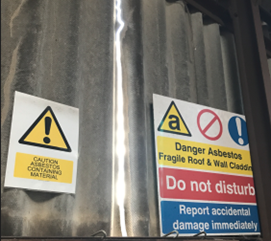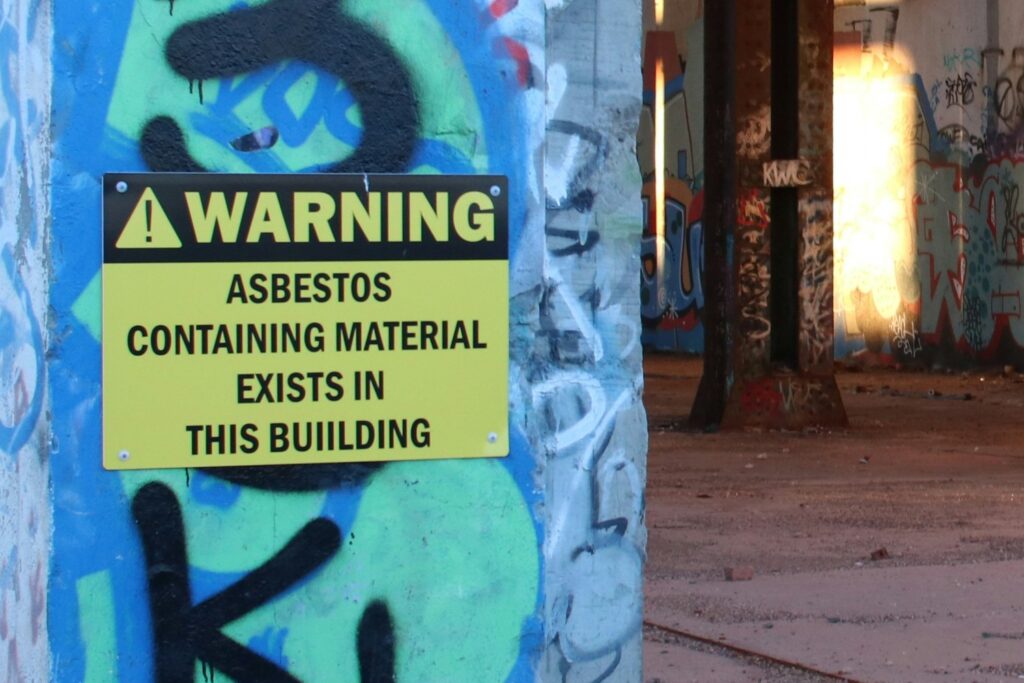What Asbestos Regulations should businesses be aware of?
It is now over 20 years since a law was introduced requiring duty holders to survey, identify and manage asbestos within their premises. However business owners still need ensure they know and understand their legal duties surrounding asbestos in the workplace.
Who is at risk of Asbestos Poisoning?
Asbestos was used in particularly high quantities in buildings materials, heat protection and other areas between 1950 and 1980. Around 5000 people per year are still dying from diseases resulting from exposure to asbestos. As most asbestos related diseases have a latency period between 10 and 50 years from exposure, lots of these deaths involve people aged over 75 who were exposed to asbestos during the manufacturing and installation of asbestos products.
It is predicted that deaths from exposure to asbestos are reaching their peak and are expected to begin falling as people are no longer being exposed.
This leads some people to believe that younger workers – people who started work in the 1990s and 2000s – are no longer contracting asbestos related diseases and that the risks are generally low.
In fact, some of those people who are contracting diseases are tradesmen who have worked in existing buildings and have been exposed to disturbed building materials containing asbestos. Such tradesmen including joiners, electricians, plumbers as young as 40 years old.
Why is Asbestos Dangerous?
Millions of properties, both domestic and industrial still contain asbestos materials within their structure. Such materials are hard to spot, even by trained surveyors. Work which involves drilling or cutting into existing building materials or which involves removing or disturbing parts of a building structure can cause hidden asbestos to release fibres. Such fibres which can be breathed in and lodge in your lungs for life.
One of the problems associated with asbestos is that you cannot see, smell or feel the fibres in the air or on your clothes, so you do not know asbestos is there. Failure to ensure that workers know when they might come into contact with asbestos, and failure to ensure that they know what procedures to follow, will put them at risk.
The HSE’s Asbestos Campaign for Business owners
The HSE has recently launched a new campaign on asbestos to help ensure that duty holders understand their legal duties to manage asbestos in buildings they control.
The HSE’s duties about asbestos include:
- Assess whether there are any ACM, their locations, the amount present and their condition.
- Presume materials contain asbestos unless there is strong evidence that they do not
- Keep an up-to-date record of the locations of ACM and their condition. This includes:
- Implement an asbestos management plan to manage the risk – this should be monitored and reviewed every 12 months and updated whenever there are any changes.
- Assess the risk of anybody being exposed to asbestos fibres.
- Provide anybody who may encounter ACMs with details – this could be plumbing and heating engineers, electricians, emergency services, construction workers etc.
- Should you conduct any intrusive building work conduct further surveying to identify any hidden asbestos before it is disturbed.

If you are a duty holder you’re required to have an asbestos management survey undertaken if your property was built before the year 2000 (formally called a Type 1 survey). This type of survey is not intrusive, and samples are only taken from materials that are accessible where there is a risk of disturbance or damage through day to day activities. A management survey is valid indefinitely, however, the Management Plan is designed to be a live document, which you must keep up to date.
Find out how to arrange an asbestos survey
If you intend to carry out demolition or refurbishment or any activity which may require interference with any structural or decorative elements such as ceilings, plaster boards or entry into any areas which would not have been accessed during a normal management survey, then you are required to arrange for a Refurbishment and Demolition Asbestos Survey (formerly known as a Type 3 survey). This is an intrusive survey designed to locate and identify hidden asbestos. A “refurbishment and demolition” survey is valid only for areas which were in scope of the planned survey and future additional surveying could be required should more intrusive work is proposed.
Since the regulations have been in place for over 20 years, it’s not uncommon to find that asbestos surveys have been mislaid and that a management plan has not been maintained. Duty holders are often unsure of whether any actions have been taken in the past to remove or encapsulate existing asbestos materials. If this is the case for you, then you must arrange for a full review by a competent person to ensure you are effectively identifying and managing asbestos. Likewise, if your survey is marked as a Type 1, these surveys may not have been conducted to the latest standards and you should arrange for a review.
Likely Asbestos risks you need to be aware of?
- The original and any subsequent asbestos surveys may have been lost, misplaced or deleted.
- The requirement for keeping a management plan may not have been understood, so a management plan may never have been implemented.
- You might not have kept up to date with your condition checks.
- Asbestos might have been damaged over time.
- Signage installed following the initial survey may have fallen down, faded or been removed.
- Asbestos materials may have been removed and management plans not updated.
- Encapsulation (special paint) of asbestos roofs, fascias or cladding may have degraded over time.
- Staff who were originally provided with awareness training may have left the business, and existing staff may not have received any training.
- Staff and management may have become complacent about the risks.
Management plans require you to carry out regular checks of the condition of your asbestos – in most cases this is a simple visual check to identify whether there has been any deterioration.
If you haven’t been regularly checking the condition of your asbestos, then it is probably time to arrange for a resurvey to be undertaken. This will provide you with a clear idea of what asbestos still remains in the property, its condition and location, as well as information you can use to create your management plan – which you can then ensure is kept up to date.
You can find information about managing asbestos here:
The duty to manage asbestos in buildings: Overview – HSE
How should Businesses remove Asbestos?
If you decide to remove, encapsulate or otherwise carry out work with asbestos you must ensure that you comply with the HSE guidance. Some work requires specialist training, and some work requires you to notify the HSE or apply for a licence. Always contact a licensed and competent asbestos specialist for abatement work and advice.
Sentient can help manage your asbestos with their advice for members.
Training
You must provide training to your employees if they are liable to be exposed to asbestos through their work. If you have asbestos on your premises, you should ensure that you nominate somebody to take charge of the asbestos management plan and you should provide them with training. Our online Asbestos Awareness training module will provide your employees with an understanding of asbestos containing materials and what to do if they discover or accidentally disturb asbestos during the course of their work.
Some of the common places asbestos can be found include:
- Roofing, cladding and fascia sheets
- Gutters and downpipes
- Sprayed coatings (limpet) – often on structural steel elements of buildings
- Pre-formed insulation such as pipe-lagging
- Insulating board material such as fire proof panels
- Gaskets on pipework
- Arc protection in electrical distribution boards
- Partition walls, linings and suspended ceilings
- Floor tiles and mastic coverings

Photographs of commonly found asbestos containing materials can be found on the HSE website.
How often should hospitality venues clean their rooves?
Failure to clean rooves or gutters, whether asbestos or other, can lead to leaks inside your premises each time it rains.
Asbestos Roofs are really common and most will now be between 30 to 60 years old and will have reached their the end of their life expectancy. Asbestos roofs and fascias are particularly common in industrial and farm buildings and can be expensive to replace. If you have an asbestos roof you might also have asbestos gutters and downpipes too. Allowing moss and lichen to grow on the roof – this can prematurely degrade the roof surface and can allow water to collect and then leak over the edges or your roof panels to the floor below. You should check that your roofs are relatively free from moss and lichen – whilst ensuring that your arrangements for checking are safe.
If you have moss on your roof, you should not attempt to clean it yourself – arrange for a competent contractor to carry out cleaning of the roof and roof lights, using the proper equipment to prevent and arrest falls.
You may be tempted to go on the roof and clean out those gutters. It is not uncommon to hear the phrase ‘if you walk on the purlins then you’ll be fine, as the purlins are always over a beam which will support your weight’. This is absolutely one of the most dangerous things you can do. The purlins on the roof are actually one of the weakest points and the cement sheet could crack under your weight. Going onto an asbestos roof without the proper equipment can also lead to falls. All it takes if for the person to trip or slip on moss, and they can fall onto the fragile panels.
Cleaning out gutters on asbestos roofs is usually a necessity but it can release asbestos fibres from the roof – therefore this tasks needs to be undertaken by somebody who has the property fall arrest protection equipment and who has had the correct training which will enable them to carry out the work safely and in compliance with the law.
The Risks of Asbestos Inhalation
Inhalation of asbestos fibres can cause cancers such as lung cancer and mesothelioma as well as serious lung diseases such as asbestosis and thickening of the pleural membranes.
The substance was once heralded as a super material in construction and fire protection. Asbestos fibres do not dissolve in water or evaporate, they are resistant to heat, fire, chemical and biological degradation and are mechanically strong – this made asbestos incredibly useful in a wide range of industries and applications. These qualities also make asbestos a deadly killer when inhaled.
Amphibole asbestos, which includes blue and brown asbestos, has rod or needle like brittle fibres. This type of asbestos is more hazardous than serpentine type asbestos and was banned in 1985.
Serpentine type asbestos, known as white asbestos, has soft, flexible, curved fibres. White asbestos containing materials were banned in 1999. It’s a popular misconception that white asbestos is relatively harmless, while the blue and brown asbestos is more dangerous. This is wrong – All asbestos is capable of causing cancer, even when a person is only exposed to small amounts.
For more information about asbestos and how to cope as a manager, see Sentient’s information. Sign in to their members area, and then go to this section: Asbestos – Health And Safety. Here you’ll find everything managers need to know about dealing with asbestos risks.



